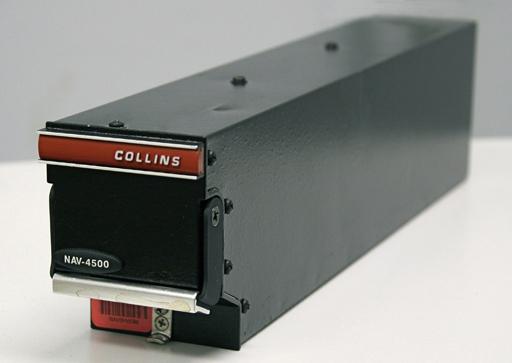 |
| 4500 receiver. (Photo courtesy Rockwell Collins) |
OVERVIEWThe Rockwell Collins NAV-4000 includes the VOR/localizer, glideslope, marker beacon and ADF receivers in a single package. In contrast, the NAV-4500 is identical in size and pinout to the NAV-4000 but does not include the ADF receiver. The NAV-4500 is intended for installations offering a single ADF receiver as standard with a dual ADF receiver as an option. The NAV-4000/4500 are members of the Pro Line 21 CNS family of products that feature state-of-the-art digital signal processing technology, digital audio, a consolidated tuning/data/audio bus, comprehensive maintenance software and software data loading. A single set of high-speed ARINC 429 I/O buses provides tuning, digital audio, navigation data, maintenance data and software data loading capability.
 |
| 4500 receiver. (Photo courtesy Rockwell Collins) |
ADDITIONAL DESCRIPTIONSNAV-4000/4500 Navigation Receiver
The NAV-4000 includes both the VIR (VOR/ILS/MKR) and ADF functionality in a single Line Replaceable Unit (LRU). The VOR/ILS, marker beacon and ADF receiver modules are the same used in the ADF-4000 and VIR-4000. The NAV-4000 supports CSDB tuning only for the VIR, not the ADF. T
The system is packaged in a 2.5 MCU configuration rather than the 2.0 MCU configuration of the ADF-4000 and VIR-4000. The VIR and ADF receivers in the NAV-4000/4500 share a number of interfaces such as tuning inputs, strapping inputs and power inputs. Some of the VIR and ADF legacy signals that are only required for Pro Line II digital system installations have not been included on the NAV-4000/4500 connector.
VOR/ILS/MKR Receiver
Both the NAV-4000 and VIR-4000 combine state-of-the-art digital UHF and VHF receivers to receive and process VHF Omni Range (VOR) signals in the frequency range of 108.0 to 117.95 MHz, Instrument Landing System (ILS) localizer and glide slope signals in the frequency range of 108.1 to 111.95 MHz and 329.15 to 335.0 MHz respectively and marker beacon signals at 75.0 MHz. The receivers utilize advanced synthesizer and Digital Signal Processor (DSP) technology to transform the received signal from RF to a base band digital signal, permitting significant circuit size reduction and providing for software reconfiguration capability.
The VIR component of the NAV-4000/4500 and the VIR-4000 operates in either the VOR or ILS receiver modes. In the VOR mode the unit utilizes the VHF receiver and outputs VOR bearing at an accuracy of ± 0.2 degrees. In the ILS mode the unit utilizes both the VHF and UHF receivers and provides localizer and glide slope deviation with a centering accuracy of ±0.002 and ±0.009 ddm (difference in depth of modulation) respectively. The marker beacon receiver is operational at all times and outputs logical levels on the data output when positioned above the three marker beacons.VOR/localizer audio is output as analog audio and also as digital audio to an RIU-4000/4100 on the unit's high-speed ARINC 429 bus. The marker beacon audio has its own analog audio output for stand-alone operation but also provides marker status information to permit tone synthesis when integrated with the RIU.
Extensive self-test and BITE capability allow detection of unit failures and ability to isolate the failure to the subassembly level. Non-volatile memory allows storage of fault conditions as an aid in isolating intermittent failure conditions and to assist in shop-level repair. This information is output on the high-speed ARINC 429 bus along with the navigation information, digital audio and software data loading capability.ADF Receiver
The NAV-4000 provides the capability to determine direction to non-directional beacons or AM broadcast stations operating in the 190 to 1,799, 2,088 to 2,094, 2,179 to 2,185 kHz frequency ranges when used in conjunction with the ANT-462 antenna system. The receivers utilize advanced synthesizer and Digital Signal Processor (DSP) technology to transform the received signal from RF to a base band digital signal, permitting significant circuit size reduction and providing for software reconfiguration capability. The ADF receiver in the NAV-4000 and ADF-4000 determines the location of the radiating signal with respect to the aircraft body and provides this bearing on its digital output bus. The ADF receiver demodulates the AM signal and provides analog and digital audio output to the RIU-4000/4100 on the unit's high-speed ARINC 429 bus. The ADF receiver also provides a BFO function to generate a 1000 Hz audio tone for detection of unmodulated or Continuous Wave identifiers.
Extensive self-test and BITE capability allow detection of unit failures and ability to isolate the failure to the subassembly level. Non-volatile memory allows storage of fault conditions as an aid in isolating intermittent failure conditions and to assist in shop level repair. This information is output on the high-speed ARINC 429 bus along with the navigation information, digital audio and software data load capability.
TYPICAL SYSTEMTwo NAV-4000 (Dual ADF) VOR, ILS, Marker Beacon, ADF Receiver. P/N 822-1465-001
Two RTU-4200 Radio Tuning Unit. P/N 822-0668-011
One ANT-462B Dual ADF Antenna. P/N 622-7384-001
NAV-4000/4500 (Single ADF, optional dual ADF)
One NAV-4000 VOR, ILS, Marker Beacon, ADF Receiver. P/N 822-1465-001NAV-4500
One VOR, ILS, Marker Beacon Receiver. P/N 822-1579-001
One RTU-4200 Radio Tuning Unit. P/N 822-0668-011
One ANT-462A Single ADF Antenna. P/N 622-7383-001
 |
| 4000/4500 block diagram. (Courtesy Rockwell Collins) |
Credits and References:
1) http://www3.rockwellcollins.com/ecat/br/Navigation_Receivers.html?smenu=4
2) http://rockwell.horizontalintegration.com/en/sitecore/content/Data/Products/Navigation%20
and%20Guidance/Radio%20Navigation%20and%20Landing/
NAV-4000-4500_VIR-4000_ADF-4000.aspx?&auth=1